Stars as a Compass kits – Preview
There are seven different kits available.
Six of them are for specific latitudes of the Earth, and one is for the Whole
Earth.
Each kit contains:
- Instructions on how to find the star groups and how to use them to find north or south.
- Posters that clearly demonstrate the method.
- Worksheets that give students practice at actually finding the stars on paper.
- A worksheet that gives students practice at finding the stars on a
computer simulated night sky.
The instructions in each kit are different, being specific to the latitude of the kit.
We have included the instructions from the Whole Earth kit on this preview page
as they give the most comprehensive overview of the methods we use.
We have also included all of the posters from all of the kits
and a representative sample of the worksheets. Please note that the previews that you
see on this web page are low-resolution web graphics.
Subscribers can
download these posters
as high quality printer-ready files which are suitable for printing at
Letter/A4 size and can be enlarged on a photocopier to Tabloid/A3 size.
Whole Earth Kit – Instructions and Posters
Search the skies for one of the three groups: the Southern Cross, Big Dipper or
Cassiopeia. From most locations, most of the time, you will be able to
find one of them. If you cannot find any of them you may have to wait
an hour or two for one of them to rise. At such times you will need low
northern and southern horizons. As soon as you have found one of these
groups of stars, you can use it to find either north or south.
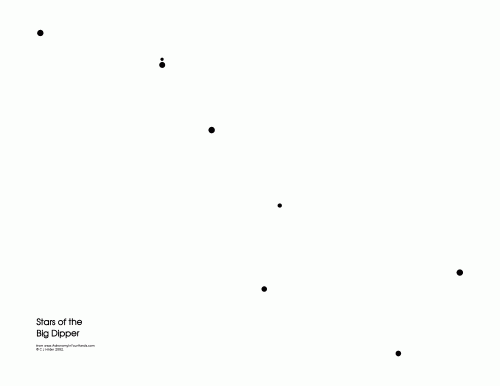
 Finding the Big Dipper
Finding the Big Dipper
The big dipper is a very distinctive shape made from seven particularly bright
stars. Once you know the shape, you will not easily mistake it.
However, there is a key that lets you check that you have the right stars.
The second handle star is actually two stars very close together.
Look for this double star – if you see it, you are looking at the Big Dipper.
Unfortunately the second star of the double will not always be visible from a
city because of the amount of light coming from streetlights. If this is the
case, you will have to rely on the distinctive shape of the Big Dipper.
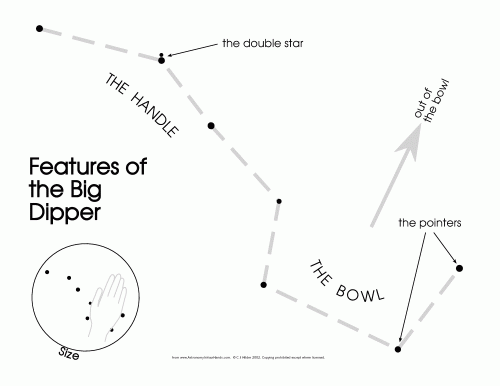

|
Finding North from the Big Dipper and Pole Star
- Find the Big Dipper.
- Find the two pointer stars in the bowl of the
dipper. The pointer stars are the outside two of the dipper bowl.
- Follow the line of the pointers out of the
bowl for three hand widths and you will come to the Pole Star.
The Pole Star may (in some locations) be below the horizon,
but if you follow the line for three hands-widths you will find
its location even though you cannot see it.
- True North is just below the Pole Star.
|

 Finding Cassiopeia
Finding Cassiopeia
Cassiopeia is a distinctive shape made from five bright stars. They form a wonky W.
To be sure that you have found the right stars, look for the sixth star.
The sixth star can be seen on one of the middle arms of the W.
If you are looking from a city this star might be very faint,
or even impossible to see, due to the amount of light coming
from streetlights. If this is the case, you will have to rely
on Cassiopeia's distinctive shape.


|
Finding North from Cassiopeia and Pole Star
- Find Cassiopeia.
- Think of the wonky W as two bowls. The Pole Star
can be found in the direction that you go to get out of the bowls.
- Of the five main stars, three of them form a line.
This line does not point to the Pole Star; it points 90° from the direction
of the Pole Star. So place your outstretched hand against the line,
and then two further hand widths coming out of the bowls, and you
will get to the Pole Star.
- True North is just below the Pole Star.
|

 Finding the Southern Cross
Finding the Southern Cross
There are many crosses in the skies, so check these keys before deciding you have found the Southern Cross.
The two keys to finding the Southern Cross are:
- The Pointers. These are very bright stars and they make a distinctive
shape with the cross.
- The Fifth Star. Many crosses have a fifth star, and it acts like a "signature."
You can tell which cross it is from the location of the fifth star.
The Southern Cross has its fifth star roughly midway between two of
its main four stars. If you are looking from a city this star might
be very faint, or even impossible to see, due to the amount of light
coming from streetlights. If this is the case, you will have to rely
on the distinctive shape made by the Southern Cross and pointers.
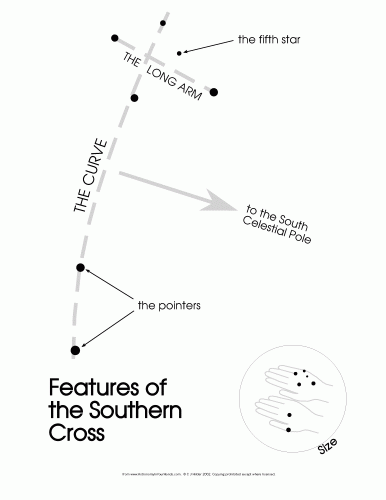
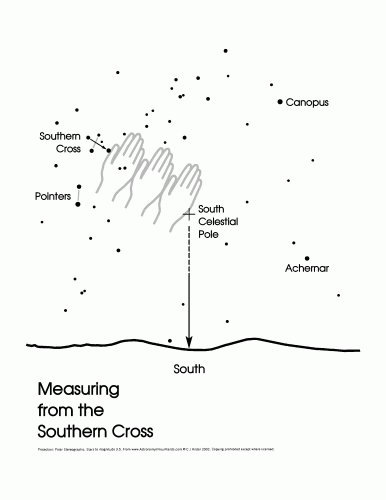
|
Finding South from the Southern Cross
-
Find the Southern Cross.
- Decide which way the curve goes (the curve is made from the pointers and the short arm). The curve points, like a satellite dish, towards the South Celestial Pole.
- Decide which arm is the long arm. Follow the line of the long arm for three hand widths and you will come to the South Celestial Pole. True South is below the South Celestial Pole.
|
Whole Earth Kit – Hunt the Poles Worksheets
These worksheets allow you to practise finding the star groups used in direction finding.
The cut-out hands allow you to practise using the method for finding the poles.
These worksheets are remarkably effective with students of all ages
providing genuine star-finding practice with a simple photocopied resource.
We have previewed one "Hunt the Pole Star" and
one "Hunt the Southern Cross" worksheet here.
The complete sets consist of 8 worksheets each, with the stars in different places.
Please note that the downloadable worksheets show much more detail than we
are able to include in these web graphics.


Whole Earth Kit – Computer Challenge Worksheets
Mirapla Sky for Windows
allows you to practise finding the star groups used in
direction finding using an accurate computer-synthesised night sky.
The cut-out hands allow you to practise using the method for finding the poles.
Instructions for the Whole Earth (kit G)
-
Start Mirapla Sky. Check that it is set for your city and country.
Click "See the Stars."
-
You will see a view of the sky to the north. Look for the Big Dipper or Cassiopeia.
You may have to look up with the
 key. If you cannot find either group of stars turn the view until
you are looking south using the
key. If you cannot find either group of stars turn the view until
you are looking south using the  and
and  keys and look for the Southern Cross.
keys and look for the Southern Cross.
-
If you cannot see any of them, you may need to advance the time a couple of
hours until one of them rises. Advance the time with the Page-Up key.
-
Use the paper cut-out Mirapla Sky hands to find either the Pole Star or
the South Celestial Pole. (In some cases you will not be able to see the
Pole Star or the location of the South Celestial Pole, but you will be
able to find its position below the horizon.)
-
From there decide which way is north or south.
-
There will be a label at the horizon telling you which direction you have found.
-
Repeat from step 1 using a different city and country.
At minimum you will need to try from three locations; say London,
Singapore, and Sydney.
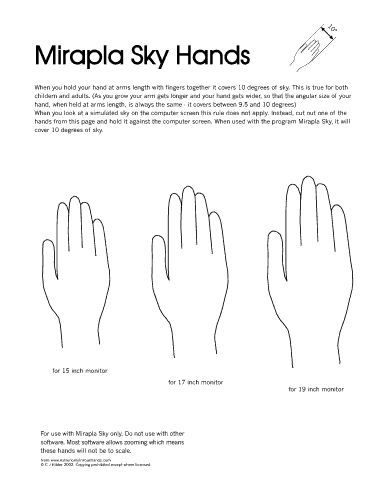 The cut-out hands come from this worksheet:
The cut-out hands come from this worksheet:
URL http://www.AstronomyInYourHands.com/activities/starcompass.preview.html
Publication date 6 Nov 2002
Copyright © C J Hilder, 2002. All rights reserved.
|












 key. If you cannot find either group of stars turn the view until
you are looking south using the
key. If you cannot find either group of stars turn the view until
you are looking south using the  and
and  keys and look for the Southern Cross.
keys and look for the Southern Cross.
 The cut-out hands come from this worksheet:
The cut-out hands come from this worksheet: